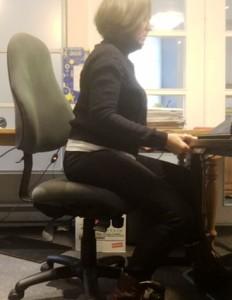 On Saturday, as I maneuvered my cart through our local warehouse store, I noticed that they were selling electric height-adjustable sit-stand desks. This is quite an exciting development in the war against sitting that has been waged in the media lately. I have long imagined a world where people had a choice to sit or stand during the day…we’re making progress! The photo at right shows Josie, standing at one of the Melnik Resources tables that we’ve had in our office for 16 years. See how happy she is?
On Saturday, as I maneuvered my cart through our local warehouse store, I noticed that they were selling electric height-adjustable sit-stand desks. This is quite an exciting development in the war against sitting that has been waged in the media lately. I have long imagined a world where people had a choice to sit or stand during the day…we’re making progress! The photo at right shows Josie, standing at one of the Melnik Resources tables that we’ve had in our office for 16 years. See how happy she is?
We’ve been finding lately that many sit-stand desks do not adjust low enough for a small-statured worker to sit comfortably. Anticipating calls asking if this is a “good” product, I was compelled to fight my way close enough to decipher the height range on the label. The lowest height for the warehouse table was 26 inches (66 cm). When I checked online, however, their website reports a range of 28-45”. If you are shopping, please double check. Sometimes manufacturers do not include the height of the actual work surface. A “standard” desk is 29-30”, so using a keyboard and mouse on this table would be more comfortable for most people than using on an old-fashioned desk, but it may not be ideal for smaller workers in your office, or at home. In my office, I use an ErgoCentric “Up-Centric” table, which goes as low as 25 1/5″ (65 cm). Fortunately, this is exactly what I need, personally.
Current ergo guidelines suggest 22″ to 48″ as a range to accommodate most workers, from sitting to standing. When you first look at a 22” (56 cm) high desk, you’ll undoubtedly think that it’s impossible for anyone to work that low. A tall male’s knee is higher than this! But I assure you that there will be people who will be very, very comfortable in this position, provided that their chair will lower appropriately. In fact, we’ve measured elbow heights that were even lower than 22”.
What difference can 4-6 inches make? Quite a lot! In fact, if you purchase one of these tables for short person, you will either need to install a keyboard tray, or you will need a footrest to support the feet when s/he works in a seated position. When you are comparing the price of various sit/stand tables, make sure that you factor these expenses into the comparison. Keyboard trays and footrests work, but they are not ideal. Here’s why:
- With a footrest, the feet are only supported when the person is sitting immediately in front of the computer. S/he can’t roll the chair over to work at the desk, or turn to face a visitor, without pressure on the back of the thigh. The only way to pull the chair close to the desk is by grabbing the desk and pulling…hard
 on the hands. As shown in the photo at right (a selfie, with my desk purposely high for demo purposes), people who sit on “high” chairs typically climb onto the edge of the seat, then pull themselves up to the table. If they don’t wiggle all the way back into the sea, they stay perched on the edge, or slouched into the seat. Unless you “wear the chair”, you can’t get good back support. Footrests are often unstable (tilt freely), not wide enough, or not exactly the right height to support the feet properly.
on the hands. As shown in the photo at right (a selfie, with my desk purposely high for demo purposes), people who sit on “high” chairs typically climb onto the edge of the seat, then pull themselves up to the table. If they don’t wiggle all the way back into the sea, they stay perched on the edge, or slouched into the seat. Unless you “wear the chair”, you can’t get good back support. Footrests are often unstable (tilt freely), not wide enough, or not exactly the right height to support the feet properly. - With a keyboard tray, the worker must sit further away from the desk, so paper documents, devices, coffee mugs, etc, all require a forward reach. Keyboard trays typically bounce a bit, so it’s not practical to rest the forearm on the mouse tray while reading the screen. The keyboard tray also increases the size (footprint) of the workstation.
If you’re purchasing a new sit/stand table, keep in mind that you’ll also need a way to raise the screen to eye level. Flat screens used to come with height-adjustable stands, but many don’t now. A monitor arm is typically best for multiple screens, but a basic stand (or stack of copy paper) will work for a single screen. If the sit/stand is for shared use, a monitor arm would allow each person to adjust the height to suit him/herself.
The moral of the story: buyer beware. Before you purchase this “latest” office gadget, get out a tape measure and measure your seated and standing elbow heights. Seated elbow height is the distance from the floor to the bottom of your bent elbow when your chair is adjusted low enough for your feet to rest firmly on the floor, with about 90 degrees at the hips and knees. (Knees and hips at the same height, elbows resting at your sides, shoulders relaxed.) Standing elbow height is the height of the bottom of the elbow when you are standing relaxed. Find a table that will meet your unique needs – the investment will pay off over the next decade or two.
Are you tall? The upper end of the height-adjustment range for most sit/stand tables accommodates most workers, even the tall ones, but if you are taller than 6’ or so, you should still check. It’s relatively easy to raise a table (by blocking up the legs), but you’ll want to plan for that.
If you’d like help introducing sit/stand options in your workplace, please give us a call!


